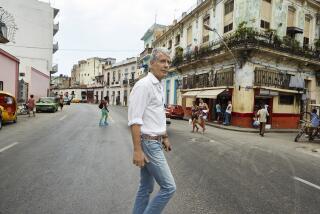‘The Madonnas of Echo Park’ by Brando Skyhorse
The Madonnas of Echo Park
A Novel
Brando Skyhorse
Free Press: 204 pp., $23
The Madonnas of Echo Park, in Brando Skyhorse’s debut novel of the same name, are a group of Chicanas who flock every Friday night to El Guanaco, “a mercado near Angelino Heights that [sells] rock-hard Twinkies, Colt 45s, and homemade tacos and burritos in the back.” It’s the same mercado prominently featured in Madonna’s 1984 music video “Borderline,” and Skyhorse uses the women as a metaphor to explore the growing pains of one Los Angeles community facing demographic, economic and cultural shifts.
The Friday night gathering is a defiant act of solidarity, the women reclaiming one of the most violent corners of Echo Park. One evening, while posing with her mother and the rest of the group for a photo, 3-year-old Alma Guerrero, “the littlest Madonna,” is killed by a stray bullet in a drive-by. This tragedy serves as the novel’s central conceit, its stories bound together by characters who weave in and out of each other’s lives in chapters set over several decades. They include a by-the-book bus driver, a mentally unstable woman who converses with the Virgin Mary, a widowed mother obsessed with Gwen Stefani, and one of the last remaining “veteranos” of the Echo Park Locos eating a heart-healthy sandwich and sipping espresso in a trendy new neighborhood café.
Skyhorse is at his best when exploring the changing world of Echo Park. In “La Luz y la Tierra,” for example, 30-year-old Aurora Esperanza, a former high school track star present during the fateful shooting, ruminates on her life while searching for her estranged mother’s dog through the topography of the now-unfamiliar neighborhood: “Bizarre ‘gentrified’ color schemes — pastel salmons and electric tangerines — coat the outlines of buildings whose shapes are recognizable,” Aurora explains, “but whose occupants and appearances are not.”
The author claims this place as his authorial turf, mapping its streets and excavating its history. His careful attention to detail, to a rich past of a place that served as home to Mexican Americans already once displaced from Chavez Ravine, is thoroughly researched and executed — no easy feat while juggling multiple characters and timeframes.
While the focus on Mexican American narrators is admirable, few of them are protagonists in any traditional sense. And, unfortunately, characters — both Latino and Anglo — are frequently mired in cliché, with subtlety and complexity pushed aside in favor of shorthand: vatos locos throwing gang signs and swigging beer, humble domestics and philandering husbands. Yes, some Mexican Americans really are gardeners, housecleaners, gang members and day laborers, but here they are often clumsily handled. “Gay for pay” Mexican men, adultery and allusions to incest and child molestation as commonplace offer a narrow view of a complicated people.
Most of these characters lack agency, appearing as either humble innocent victims of circumstance (like Hector, who accepts $500 to dispose of a murder weapon after his boss’ son kills a day laborer) or dehumanized brutes driven by their bellies, their greed and their libidos. For example, there is Freddy Blas, narrator of “The Hustler,” who, released after serving a 12-year sentence for aggravated battery, finds himself confronting an angry lesbian when he appears at the door of his mistress Cristina’s former residence. Across the street at the house of Julianne (with whom he was also sleeping), he learns about his former lover’s tragic death. Freddy ends up at the Little Joy Jr. bar, a former gay nightspot where the “bathroom used to be as reliable as an ATM.” There, he is beaten up by a hipster after a pool game and tossed out on the curb, his hopes dashed.
There are lyrical moments in Skyhorse’s writing, but too often he misses the modulations of tone and voice possible with the use of multiple perspectives. As a result, the book’s narrators are more like a Greek chorus than polyphony, even to the point of using identical language and descriptions: Two characters, for example, call a GMC pickup truck “mushroom brown,” evocative once, redundant twice. Ultimately, these voices capture little of the nuance, eclectisism and generational variations present in the English, Spanish and Spanglish of Los Angeles’ Latino communities. Moreover, the editorial decision to italicize the Spanish exoticizes a segment of the population fully integrated into the fabric of life here, marking the language foreign in a city and state whose very names are Spanish, where Latinos are not an “alien other,” where they make up the largest ethnic population in the city. Those whose knowledge of the racial strife and generational tensions within Southern California’s Latino community comes from watching films like “Mi Vida Loca,” “Crash” or “Quinceañera” will find Skyhorse’s novel reifies what they think they already know about this “unseen” segment of the population.
The power of the works of Dagoberto Gilb, Yxta Maya Murray and Helena María Viramontes rests in these authors’ ability to humanize the people they write about, in their indictment of those in the media and publishing who consistently under- or misrepresent Southland Mexican Americans. Lending his voice to L.A.’s rich Latino canon won’t be hard for Brando Skyhorse as long as he learns to handle his characters with the same amount of dignity with which he handles the geography they inhabit.
Espinoza is the author of the novel “Still Water Saints” and teaches English and creative writing at Cal State Fresno.
More to Read
Sign up for our Book Club newsletter
Get the latest news, events and more from the Los Angeles Times Book Club, and help us get L.A. reading and talking.
You may occasionally receive promotional content from the Los Angeles Times.






